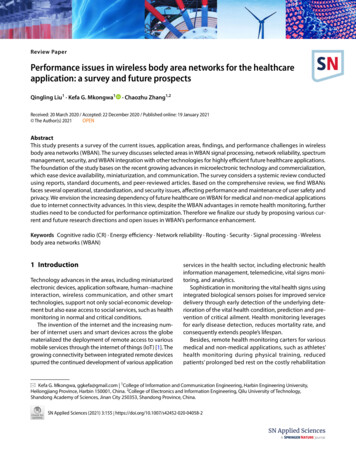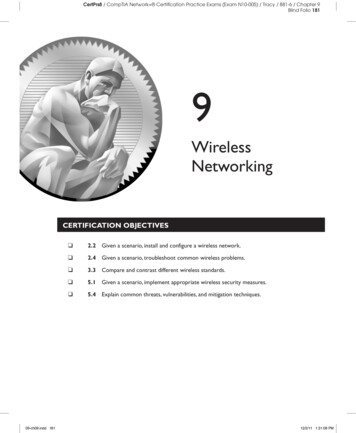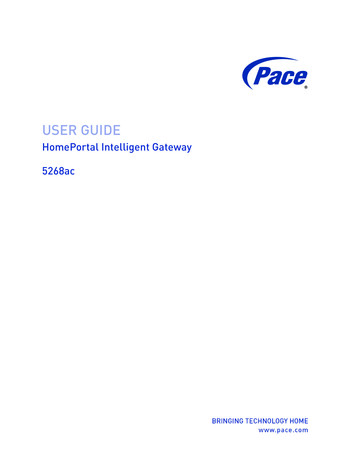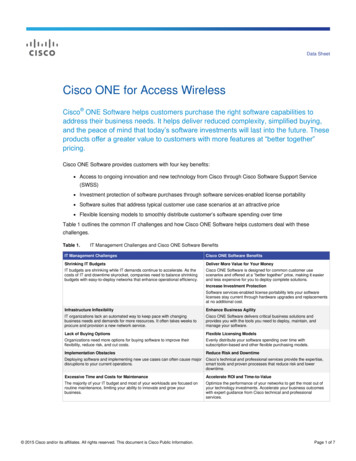
Transcription
Review PaperPerformance issues in wireless body area networks for the healthcareapplication: a survey and future prospectsQingling Liu1 · Kefa G. Mkongwa1· Chaozhu Zhang1,2Received: 20 March 2020 / Accepted: 22 December 2020 / Published online: 19 January 2021 The Author(s) 2021 OPENAbstractThis study presents a survey of the current issues, application areas, findings, and performance challenges in wirelessbody area networks (WBAN). The survey discusses selected areas in WBAN signal processing, network reliability, spectrummanagement, security, and WBAN integration with other technologies for highly efficient future healthcare applications.The foundation of the study bases on the recent growing advances in microelectronic technology and commercialization,which ease device availability, miniaturization, and communication. The survey considers a systemic review conductedusing reports, standard documents, and peer-reviewed articles. Based on the comprehensive review, we find WBANsfaces several operational, standardization, and security issues, affecting performance and maintenance of user safety andprivacy. We envision the increasing dependency of future healthcare on WBAN for medical and non-medical applicationsdue to internet connectivity advances. In this view, despite the WBAN advantages in remote health monitoring, furtherstudies need to be conducted for performance optimization. Therefore we finalize our study by proposing various current and future research directions and open issues in WBAN’s performance enhancement.Keywords Cognitive radio (CR) · Energy efficiency · Network reliability · Routing · Security · Signal processing · Wirelessbody area networks (WBAN)1 IntroductionTechnology advances in the areas, including miniaturizedelectronic devices, application software, human–machineinteraction, wireless communication, and other smarttechnologies, support not only social-economic development but also ease access to social services, such as healthmonitoring in normal and critical conditions.The invention of the internet and the increasing number of internet users and smart devices across the globematerialized the deployment of remote access to variousmobile services through the internet of things (IoT) [1]. Thegrowing connectivity between integrated remote devicesspurred the continued development of various applicationservices in the health sector, including electronic healthinformation management, telemedicine, vital signs monitoring, and analytics.Sophistication in monitoring the vital health signs usingintegrated biological sensors poises for improved servicedelivery through early detection of the underlying deterioration of the vital health condition, prediction and prevention of critical ailment. Health monitoring leveragesfor early disease detection, reduces mortality rate, andconsequently extends people’s lifespan.Besides, remote health monitoring carters for variousmedical and non-medical applications, such as athletes’health monitoring during physical training, reducedpatients’ prolonged bed rest on the costly rehabilitation* Kefa G. Mkongwa, ggkefa@gmail.com 1College of Information and Communication Engineering, Harbin Engineering University,Heilongjiang Province, Harbin 150001, China. 2College of Electronics and Information Engineering, Qilu University of Technology,Shandong Academy of Sciences, Jinan City 250353, Shandong Province, China.SN Applied Sciences (2021) 3:155 23456789)
Review PaperSN Applied Sciences (2021) 3:155 https://doi.org/10.1007/s42452-020-04058-2process and avoidance of the unnecessary frequent movement to the health care facility through swift remote dataaccess [1]. However, in the future, the aged populationmay face several unforeseen health challenges due to thechanging lifestyles and higher susceptibility to age-relateddiseases (NIH/WHO, 2011). Some of the common agerelated diseases at the moment include; dementia, diabetes, blood pressure, and cardiovascular disorders. On thisbasis, addressing prospective future health threats andmitigation measures requires continued exploration ofthe challenging health issues and technical sophistication.Focusing on the aging population with the rising lifeexpectancy across the globe due to advanced medicineand healthcare technology, measures to monitor andrespond to future unanticipated health challenges necessitate the use of smart interactive technologies, such asthe use of wireless biological sensors and actuators fixedwithin, on or off the body of a remote subject [2]. In thisview, as a result of advances in technology, Moore’s lawsignifies the on-going miniaturization and mass production of sensor devices with improved operational performance for different application areas. Therefore, affordability, flexibility, and device usage versatility are on the rise.Correspondingly, due to sophisticated sensor technology,in recent days we find ubiquitous deployment of the automated systems in healthcare applications, including ambient assisted living. For example, commercialized wirelesscontrolled robots in developed countries taking care ofvarious security, social, and healthcare services delivery [3].To date, wireless body area network (WBAN) is a technology that is widely deployed in the health care sector forremote health monitoring within or outside hospital premises. WBAN uses coordinated biological sensors to collecthealth information of the monitored body condition. Thecoordination of the sensors with the actuators, provideconditional responses to health ailment. For example, theuse of miniaturized actuators for insulin injection in highblood sugar regulation.Wireless body sensors consist of the transducers for signal detection, a power source, and the transceiver circuitryfor wireless linkages. WBAN uses battery-powered wireless biological sensors to measure and transmit vital information over the wireless media to remote health units.Due to the reduced size of the biological sensors, WBANdevices cannot be replaced easily. Similarly, the durability of the WBAN battery depends on its size. Therefore, aminiaturized battery size threaten WBAN operational lifetime. Apart from power constraints, WBANs face hindranceand other media impediments due to the harshness of theworking environment or interfering frequencies in thetransmission channel when operated near other deviceswithin the same radio frequency spectrum such as ZigBeeand WiFi coexistence in the ISM band (2.4 GHz).Vol:.(1234567890)In the ISM band, the support bandwidth is limited,raising the possibility of excessive packet collision, signal interference, complex channel access mechanismsduring transmission, increased routing overheads, andpacket queuing delays when the number of active devicesincreases [4]. Similarly, miniaturization of sensors limitsmemory capacity and hence the information processingcapabilities, which further affect energy efficiency, link reliability and packet transmission due to network resourcecompetition.For body implants, a set of WBAN receivers’ and transmitters’ radiating elements work over the curved bodysurfaces exposed to nearly 70% of body fluids (tissue).The body tissues’ absorption characteristics increase radiofrequency (RF) thermal effects and WBAN signal attenuation. Besides, tissues’ absorption characteristics affectsignal transmission and other biosensor circuit transients.Alterations in the circuit transients may change the dataacquisition devices’ operational characteristics resultingin data anomalies, devices, and network faults. Also, thesignal attenuation due to tissue absorption characteristics weakens the signal strength; hence it can easily bedisrupted by noises [5].In addition, body movement affects RF signal propagation due to the varying dynamics and the WBAN topologyresulting in changing packet transmission distance andlink outages that disrupt reliability [6].Based on the constraints faced by WBANs and its necessity for future healthcare, the emphasis for performanceenhancement and improved quality of service for efficientoperation under the resource-constrained and challengingenvironment is required. In this essence, future modernhealthcare services depend on the quality of service delivered by the technology enablers embodying; affordability,flexibility, and operational efficiency.On the other hand, the fast-growing WBAN commercialization may raise security and user privacy issues besidesother performance concerns. Jeopardized health information may raise legal and loyalty issues. On this basis, healthinformation requires higher confidentiality and adequatelymaintained user privacy. However, WBAN pervasivenessand the increasing number of users increases its securityvulnerability, leading to a possible information breach andperformance degradation due to adversarial constraints.Adversaries may mislead medical diagnosis, jam the communication network, and use medical information for illegal practices. Therefore, measures against security breachneed to be well implemented [7].Due to limited memory and computational capacity,most of the conventional security features in WBAN enabled protocols use authentication keys which are not sufficient in securing user data. Since attackers use advancedtechniques, WBAN commercialization for universal health
SN Applied Sciences (2021) 3:155 ng requires advanced countermeasures to maintain user privacy and avoid falsified diagnosis. Therefore,despite its advantage and an increasing dependency forfuture healthcare, WBANs have several flaws in need ofcontinued research to address current and future securitychallenges.Generally, the growing WBAN commercializationaddresses many areas that require further research forcompelling future applications. Universal deployment ofthe WBAN for health monitoring needs low cost devices,comfortability, improved accuracy, integrity, extendedmemory systems, information security, user safety, properspectrum management, link reliability, mobility convenience, and energy efficiency.This survey aims to discuss some of the driving andopen performance issues to the current and future WBANapplication technologies in improving efficiency throughsignal processing with concerns for packet processing andqueuing delays, information security, and reliability withtheir contribution to WBAN operational performance.The design of the study in this article bases on systemicliterature review approach. We identified areas of importance today and of the future by reviewing articles, standard documents, and reports with influence in WBAN topics of interest. Selection of the reports and articles’, basedon the key topics’ relevance, year of publication, articleinfluence, or citations number between 2011 and 2020.In the review process, we identified application areas, current achievements, and technological gaps now and in thefuture. Hence, projections for current and future WBANresearch bases on the foundation of the literature.The survey is organized into the following sections;Sect. 2 discusses IEEE 802.15.6 (WBAN) standard overview,Sect. 3 covers the WBAN architecture, channel model, andsecurity vulnerability, Sect. 4 gives a review of the literature, Sect. 5 discusses selected application areas, Sect. 6covers prospects for open research fields, and Sect. 7 concludes the survey.2 IEEE 802.15.6 (WBAN) standard overviewWBAN standard falls under the IEEE 802.15 task group6, specified for short-range communication, extremelylow power, applications requiring high quality of service(QoS), and data rate up to 10Mbps [8]. It supports bothphysical and data link (MAC) mechanisms and conformsto the standard frequencies used worldwide for medicalpurposes.In the physical layer (PHY), the WBAN standard isresponsible for; activation and deactivation of the radiotransceivers, clear channel assessment (CCA), datatransmission and reception. The PHY supports signalReview Paperpropagation through Ultra-wideband (UWB), non –radiohuman body communication (usually referred to asHBC), and an optional narrow-band (NB) communication.IEEE 802.15.6 is not limited to support radio frequencybands, such as ISM, medical implant communicationservices (MICS), and wireless medical telemetry services(WMTS) [9]. Detailed frequency range supported by theIEEE 802.15.6 standard is given in [8].In the data link layer (mainly referred to as MAC), IEEE802.15.6 standard is responsible for control channelaccess mechanisms, supporting carrier sense multipleaccess with collision avoidance (CSMA-CA), time divisionmultiple access (TDMA), or a combination of both CSMACA and TDMA. The standard supports three differentchannel access scheduling modes, categorized basedon the time referencing of the superframe and allocation slots. Time referencing determines the device synchronization and network association during mediumaccess scheduling. The IEEE 802.15.6 standard accessmodes are; beacon mode with superframe boundarieswhose time reference allocation depends on the beaconarrival. Non-beacon mode with superframe boundarieswith which devices need not wait for a beacon signal.However, the superframe time referencing is predefined.Also, there is a non-beacon mode without superframeboundaries, which does not need time referencing toset up superframe and allocation slots [8, 9]. For a beacon mode, the MAC layer channel is divided into superframes of equal length. The superframe is subdividedinto different fields assigned to different types of traffic.The superframe fields include Exclusive Access Phase(EAP), Random Access Phase (RAP), Managed AccessPhase (MAP), and the Contention Access Phase (CAP), asdescribed in [8, 10].Further, the standard gives provision for three security levels; 0, 1, and 2. In security level 0, there is no dataauthentication nor encryption, the application is completely insecure, security level 1 has medium level security allowing data transmission in secured authenticationwithout encryption, and security level 2 involves datatransmission in a secured authentication with encryption frames.3 WBAN architecture, channel model,and security vulnerabilityThis section discusses the architectural flow of the information in WBANs involving individual body area networksbeyond the WBAN communication range. We also discussessential features to be included for the transmission channel model and WBAN security-related issues.Vol.:(0123456789)
Review PaperSN Applied Sciences (2021) 3:155 https://doi.org/10.1007/s42452-020-04058-23.1 WBAN architectureWBAN is composed of sensors and actuators linked by acomputing unit. Sensors measure biological parameterssuch as blood pressure, temperature, sugar, echo-cardiograph (ECG), electroencephalograph (EEG) and otherbody vital signs while actuators respond to the instruction based on the sensor measurement after computation[11]. For example, in diabetic illness, the actuator regulatesblood sugar by controlling the insulin level. WBAN sensorscan be deployed in or on the body using invasive and noninvasive techniques as body implants, surface contacts, oras wearable devices. The coverage distance of the WBANdevices in transmitting and detecting signals is limitedto within the body. However, with the assistance of othertechnologies like WiFi, WAN, ZigBee, and other wirelesscommunication technologies, WBAN can forward information to the remote health care units for further decisionsupport.Figure 1 illustrates a WBAN and beyond WBAN architecture comprising of three functional sections, namely;intra-BAN, inter-BAN, and the health care unit. The intraBAN segment composes wireless biological sensors whichcan measure and share information between themselvesand also interact with the coordinator (master node) [12].An intra-BAN’s master node can manage and aggregatemeasured physiological parameters from source devices[13]. Further, an intra-BAN’s master node has abilities toforward information to the computing unit, or couplingof the intra-BAN to other networks, such as neighboringWBAN, gateways, access points, or telecommunicationsbase stations [12]. Inter-BAN section, which is representedby the wireless interface, links the intra-BANs’ coordinator with the access points, neighboring WBANs, or bodyto body communication (B2B). Also, the inter-BAN linksdata from the individual WBAN with the health caretakers, and the data processing centre through the long haulFig. 1 WBAN and beyond WBAN architectureVol:.(1234567890)telecommunication networks. Similarly, the inter-BAN section may also have Personal Digital Assistant (PDA) andsmart digital displays linked to the intra-BAN coordinatorproviding interactive user interfaces when accessing information for personal awareness. The data processing centre systems compute and analyze received information forhealth-related prognosis and decision support for medicalprofessionals.In the data processing centre, health care applicationsuse vital physiological signs collected through WBAN toassess the health status of individuals. After the assessment of the health information, results are used in decision support for the provision of treatment or preventivemeasures to the monitored individuals before symptomsseverity.Based on the sensitivity of remote health monitoringand prognosis, WBAN has captured the researchers’ attention and interest as one of the exciting research fields [14].Apart from the current research dominance in designing wireless body area networks’ devices and routingmechanisms, the growing user demands and curiosityremain as the major challenge for the limited networkresources and the underlying technology [15]. Increasinguser demand calls for researchers to unfold prospectivefuture challenges due to a projected increase in data rates,data volume, inter-BAN communication in the wirelessinterface (colocation), as well as the requirement for network security, reliability, and standardization [16]. Moreover, in sports and assisted living, consideration for postureand mobility of the monitored individuals are some of theareas which need attention when instilling patient-centricmanagement.3.2 WBAN channel modelWBAN networking is challenging due to the complex signal propagation mechanism in the vicinity of the humanbody. Signal propagation may depend on several factors,including distance between devices in the line or non-lineof sight, path loss, and other media characteristics. WBANmovement may result in topology changes, shadowingof biosensors, signal reflection, diffraction, and scattering. Hence, it is not easy to guarantee each sensor a directlink from the coordinator [17]. Based on nature and WBANenvironment, such constraints may result to deep fadingeffects and performance degradation. Therefore, reliablecommunication in a dynamic channel conditions need agreater understanding of the communication channel [18].WBAN communication model should be appropriateto the propagation model and communication scenarioconsidering point to point link and environmental viability.WBAN propagation methods include:
SN Applied Sciences (2021) 3:155 https://doi.org/10.1007/s42452-020-04058-2(i) Narrowband (NB) communications it uses lowcarrier frequency and suffers less from the signalattenuation by the human body. However, NB suffers more from signal interference in dense networks.(ii) Ultra-wideband (UWB) communication supportshigher data rates and is suitable for low power consumption.(iii) Human body communication (HBC) In thismethod, signal communication is performedthrough electric field coupling, where transmission is over a medium of human skin by electrodesusing capacitive or galvanic coupling withoutantennas.Besides propagation methods, the WBAN channelmodel may fall under three communication scenarios;on-body, in-body, and off-body communication setups.On-body communication involves the sink node and itslinked sensors on the body surface. In-body communication involves linking body implants within the body andoff-body communication whose sensors and coordinatorsmay communicate within 3 m around the human body.The signal propagation from different communication scenarios varies from one another due to the varying propagation medium [19].WBAN users may be mobile or fixed, and sometimeswith varying node distribution or changing body posture.Therefore, defining a proper channel model is complicated[20]. Similarly, the communication model may be affecteddue to the variations of the user body sizes, shape, skintexture, and flexibility. Features associated with the subject determines the quality of the signal communication[17, 21]. In a very dynamic environment of a signal carrier,such as WBAN application, network designers must consider several normalized features when proposing a transmission model. Different models are commonly used inwireless communication based on statistical distributions,including Rayleigh, Weibull, Normal, Lognormal, Gamma,and Nakagami. However, the authors in [17] declares thatRayleigh fading, line/non-line of sight models are bothpoor models for WBAN radio channel since WBANs canexperience deep fade that lasts long in few seconds. Similarly, the channel model using distance-based path loss isinaccurate since the values of the path loss exponent forboth NB and UWB varies, even in similar environments.Hence, the models may not be energy efficient for a WBANstandard.However, selection of the best WBAN channel modelmust take into consideration of other channel conditions, including factors, such as scattering, reflection, ordiffraction, which changes based on the subject activityReview Paperbesides the distance-based path loss models for reliabilityenhancement.3.3 WBAN security vulnerabilityWBANs use a license-free spectrum under ISM, whichraises more security and performance concerns. In thisessence, the growing number of users shortly may eventually attract more adversaries breaching user informationand jeopardize its operational efficiency. Attacks can belocated in different layers of the architecture, such as atthe intra-BAN (layer 1), inter-BAN (layer 2), transmissionmedium (layer 2), and at the data repository centers (layer3) as illustrated in Fig. 2. Besides threatening user privacy,attacks in WBAN may also focus on degrading networkperformance by introducing malicious information andaffect the quality of service by overwhelming transmissionbandwidth capacity, energy inefficiencies, increase packetloss, and link instability.Attacks may be launched through security loopholes ofthe WBAN protocols at different architectural levels. Thetypes of attack include the use of shared authenticationkeys in multi-hop communication schemes, the use ofcounterfeit acknowledgment packets, signal jamming, anddistributed denial of service (DDoS) due to limited WBANdevice memory operating in the big data [22].4 Literature surveyProspects for health care services show an increasingdemand for healthy living in line with advances in technology and innovation. As the world fertility rate is decreasing, studies in [23] have shown that adults with smallfamilies have a longer lifespan compared to larger ones,Fig. 2 Layers of attacks in WBANsVol.:(0123456789)
Review PaperSN Applied Sciences (2021) 3:155 https://doi.org/10.1007/s42452-020-04058-2so in the future, the elderly population is expected to behigher than that of the youth. In this view, where there islimited attention to elders, alternative health care supportapplications must meet user expectations in terms of portability, sensitivity, accuracy, durability, integrity, security,and interoperability [2, 23]. Further to that, technologyadvances in health care services anticipate fully deployment of the wireless body area networks to do more thanit can do today for remote health and mobility monitoringand communication over the wireless interface.In the following subsections of the survey, we discussWBAN performance improvement issues, which recapitulates key challenging areas on the basis signalled throughsignal processing, security, network routing and reliability. In the discussion, we also include essential considerations on the path loss, anomalies, and network faultssince shortly the healthcare system avails to the big dataprocessing.4.1 Signal processingThe commercialization of miniaturized WBAN devicesanticipates for an increase in the number of WBAN users,which signals for the enormous demand in networkresources management and utilization due to higher datatraffic. The considerable data volume from users raises newWBAN requirements to support higher data rates with limited network resources in the transmission channel. Apartfrom the increasing network devices causing the rise indata volume, other sources such as abnormal changes indata configuration and frame structure due to insertionand forging of data by adversaries may also contribute toexcessive network resource requirements due to noisesand anomalies [7].For real time health monitoring, communication ofthe streaming video (e.g., endoscopic capsule) and ECGtrace demands higher bandwidth and transmission powerdue to complications which may be associated with dataacquisition noises, data volume, and transmission channelerrors. Such requirements may rise performance degradation issues requiring costly mitigation measures. For example, for error reduction and enhancement of the qualityof the time series ECG amplitude patterns, i.e., P, Q, R, Sand T, in [24] authors use adaptive mapping process of thechannel quality indicator (CQI) to enhance the quality ofthe ECG signal by reducing possible channel coding errorsusing conservative modulation and coding. However, thereduction of channel errors affects the throughput performance of the network due to bandwidth limitations.So, application of the signal processing algorithms suchas wavelets analysis, K-means classification, Markov orBayesian network models (MM/BNM), are used for dataVol:.(1234567890)dimension reduction (feature extraction), classificationand anomaly detection, respectively. Although, application of these methods must consider trade-offs betweensignal quality due to channel coding and network performance parameters such as energy efficiency and throughput [25].Besides, as the data volume increases in parallel withWBAN commercialization, processing of the medical information at the node level reduces the excessive requirement of the network resources in the transmission channel[26]. In this essence, simplification of data size at the nodelevel may include the implementation of various datacompression and coding technique, sampling, featureextraction, segmentation, and classification. Performingnode level signal processing lowers traffic in the transmission channel, reduce latency, data collisions, and link droprate due to reduced network resource competition [26, 27].However, node level signal processing faces several challenges including its complexity on timing and synchronization between operations, need for specific applicationlanguage developers, computing power constraint andlimited memory size with adverse effects on data processing overheads [28].Proactive measures using feedback systems in WBANbuilds another necessity for signal processing within bodyarea network coverage. In intensive care units, patients’physiological data require accurate monitoring in everysingle unit of time. Therefore, unregulated variation of anyparameter may endanger patients’ life. So, the feedbacksystem, which only based on the analysis of the sensedvital signs such as respiration rate, Myocardial infarctionand oxygen concentration in the blood need immediatereactive emergency measures from the actuation systemon such discrepancies. The feedback system may includelocal alarms to alert physicians and carers or actuatorsusing electromechanical principles for the immediatereaction [29].Moreover, spectrum sensing and management areamong the critical issues in WBAN communication sincestudies have shown [30]; most of the licensed spectrumare unused. Although network designers are keen aboutnetwork resource utilization, they have not given enoughbalance on reliable data routing, node parameters management, configurable networking, and other cognitivefunctions. Also, the heterogeneity and growing demandfor network resources, the WBAN operation under theunlicensed industrial, Scientific and Medical (ISM) bandmay not be enough. Due to scarce resources, WBAN mayrequire to use unlicensed frequency band outside theISM spectrum. On this basis Cognitive Radio (CR) enabledbase stations can be used for spectrum sensing and allowWBAN to access and transmit packets to the related medical units [12]. So, incorporating WBAN and CR technology
SN Applied Sciences (2021) 3:155 https://doi.org/10.1007/s42452-020-04058-2(CRT) will enhance efficient use of the radio spectrumthrough spectrum aware routing and resource allocationin reducing interference while improving other communication features and the quality of service [31].4.2 Energy efficient routing and network reliabilityEnergy is a fundamental driving force of any network.However, apart from energy efficiency, effective monitoring of the remote health critical situation depends onnetwork timeliness, routing and link reliability. Reliability of the wireless network infrastructure counts on thecomposition of the features, including; reduced discordant in data, minimum link and packet drop rates, lowerend to end packet delay, network lifetime longevity,interference-free communication, and channel utilizationwhich ensures network survival and efficient delivery ofthe WBAN assignments [26]. Usually, networks which cancommunicate information through a range of deviceswithout hindrance or errors are regarded to be of highertransmission reliability. On the basis of energy efficiency asa fundamental resource of network opera
various security, social, and healthcare services delivery [3 ]. To date, wireless body area network (WBAN) is a tech-nology that is widely deployed in the health care sector for remote health monitoring within or outside hospital prem-ises. WBAN uses coordinated biological sensors to collec










